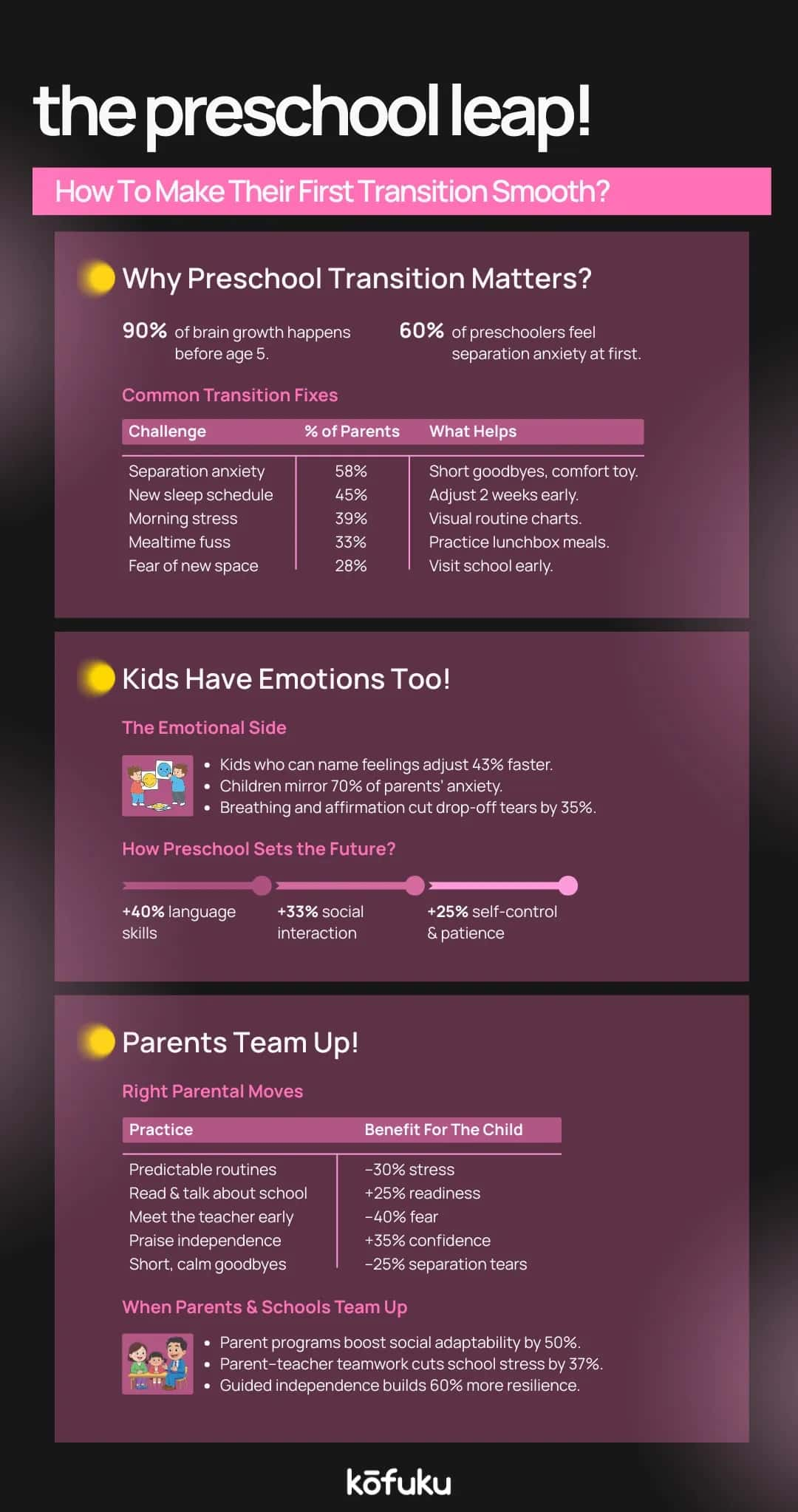Ready, Set, School: A Parent’s Guide to a Smooth Preschool Transition

Introduction
As summer ends, parents in India feel a blend of excitement and apprehension. Sending a little child to preschool represents a new beginning, and for many families, it is the first time.
However, while back-to-school is heartwarming, it can also be overwhelming for parents. Clingy toddlers face new environments, unfamiliar people, and, for the first time, a school routine —a lot for them to handle.
Fortunately, this is one of many moments in development when a little planning can make a big difference. Emotional planning and a few preschool transition tips can help parents feel confident that the school side of the home-to-school shift will be positive, not stressful.
Understanding Your Child’s Needs During the Back-to-School Transition
Preschool is a new and sometimes even an overwhelming experience for children. During the first days, some may cry at drop-off, while others may withdraw and cling to their parents.
It is natural for children to react this way, and it is entirely normal. For children, returning to school opens new schedules, peers, teachers, and environments to build trust.
This change is challenging during early childhood, as toddlers prefer predictability and familiarity, while new situations call for adaptation.
To promote adaptation, one simple approach is to consider your child’s personality and comfort levels. While some toddlers may adapt quickly, others do require more time and reassurance.
Provide reassurance and comfort by talking about school and what to expect, including the new friends, teachers, and fun activities.
Preschool Transition Tips: Setting Routines and Expectations Early
Starting preschool successfully, with minimal to no challenges, is anchored in predictability. This is one of the key preschool transition tips. It focuses on developing a daily routine aligned with the new school schedule in preparation for the school year.
About two weeks before the start of school, begin the process of adjusting your child's sleep schedule. Move the meal and snack times closer to the school schedule as well, to help the body gradually adjust.
Before school starts, encourage your child to engage in calm play or reading during times when structured learning will occur in school.
Preparing Emotionally: Helping Your Child Cope with Change
Emotional preparation must be considered alongside physical preparation. Anxiety in children is often expressed in the form of clinginess, irritability, or resistance. In the face of these opposing behaviours, calm reassurance and consistent activities will ease the child.
Visit the school with your child before the first day. It will help to ease their anxiety if they can see the classroom, playground, and the teacher.

In the beginning, say goodbye briefly while remaining confident, as long emotional farewells tend to heighten your child’s emotional state. With a warm hug, say you will return after school, and leave calmly.
You can also send a comfort item, such as a small toy or a family picture. Many preschools encourage this practice during the early weeks to help alleviate separation anxiety.
Practical Tips: Organising Supplies and Establishing School Habits
Preparing the night before is one of the easiest preschool transition tips. Lay out uniforms, pack bags, and make sure everything is labelled, including lunch boxes and water bottles.
In India, busy mornings and the little delays that occur can turn into chaos very quickly. Both children and parents will feel stress. A "school corner" at home, a designated area to keep all school belongings, is an excellent way to ensure nothing important gets left behind.
During the back-to-school phase, pack thoughtfully and lightly. A change of clothes, healthy snacks, wipes, and any comfort items the school allows are all that is needed. Children will tire if they carry a bag that's too heavy, so avoid overpacking.
Communicating Effectively with Teachers and School Staff
A successful preschool transition relies on building a strong relationship between parents and teachers. Respectful and open communication allows all parties to support the child coherently.
As a starting point, provide pertinent information about your child, such as habits, allergies, and anything that could trigger behavioural changes. Teachers welcome information that enables them to reach students better.
You may reach out to staff regularly, especially in the first month, and inquire about your child’s adjustment, appetite, participation, and social interactions. Again, do not overcheck or show up unexpectedly, as this could confuse your child or break existing routines.
If your child is having a hard time, consider working with staff to implement strategies like comfort check-ins or shorter initial hours before you decide to withdraw them. Children do better when they perceive a united front, combined with strategy, from home and school.

Managing Parent Anxiety: Staying Positive for Your Child
Parents feel a bit anxious about starting preschool, too. Parents often feel guilty about disengaging from their child or feel self-doubt. Acknowledging those feelings is the first step to resolving them. Your child will pick up on your feelings, so you want to project a calm, confident energy.
As the school season approaches, keep yourself occupied with a quick stroll, a book, or a catch-up with a friend after the school drop-off. This helps you avoid waiting near the school gate or incessantly calling to “check in.”
This time can be used to appreciate the new milestones in your child’s life as they learn to be more independent, form new friendships, and acquire new competencies.
Remember, it’s about celebrating the progress they’ve made, not the perfection you expect. Support groups can ease you through this emotional stage.
It helps to share your experience with others because it gives you the perspective that you are not alone. Many parents experience the same pride and anxiety you feel during the preschool transition.

FAQs
Q. How can I help my child feel more comfortable about starting preschool?
A. Talk about school positively, visit beforehand, and read books about starting school. Establish routines and reassure your child that you’ll return after class.
Q. What routines should I establish before the first day of school?
A. Align bedtime, wake-up, and meal times with the school schedule. Practise dressing, packing, and saying goodbye to create predictability and comfort for your child.
Q. How do I manage my own anxiety about my child's preschool transition?
A. Acknowledge your emotions, trust the teachers, and stay positive. Avoid showing worry during drop-offs. Use time apart for self-care or productive tasks.
Q. What are the best ways to communicate with teachers during this transition?
A. Maintain open communication. Share relevant details about your child, attend parent meetings, and check in regularly while respecting the teacher’s time and boundaries.
Q. How can I prepare my child emotionally for going back to school?
A. Discuss what school will be like, meet the teacher early, and practise short separations. Offer reassurance and use praise to build confidence.
Q. What supplies should I prepare for my child's first week at preschool?
A. Pack essentials like a labelled water bottle, healthy snacks, spare clothes, wipes, and comfort items. Keep it simple and organised to reduce stress for both of you.

A Guide for First-Time Parents in 2025 – Best Advice

Navigating Quarantine with Kids: A Parent's Survival Guide

Resorcinol Cream: Why This Skin Treatment Still Matters Today

Teaching Gentle Behaviour to Toddlers: Effective Parenting Tips

Infant and Toddler Health: Why Supplements Like Vitamin D and Calcium Are Important


